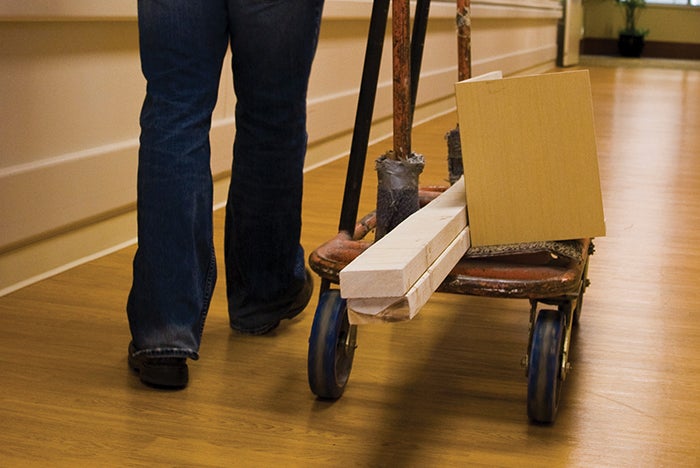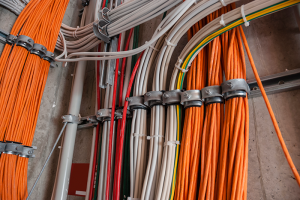The role of maintenance in infection prevention

Facility professionals routinely perform risk assessments to make sure construction work will have a minimal impact on patient safety and comfort.
Image courtesy of ASHE
Health care facility engineering and maintenance staff play an important role in providing a safe and healing environment for patients, visitors and staff.
The look and feel of a health care facility impacts the first and lasting impressions of patients and visitors. A properly maintained and operated facility provides an environment that patients expect and deserve.
Although facility professionals understand they play a role in reducing or eliminating health care-associated infections (HAIs), a closer look at the many ways they assist in this effort and additional ways they can do even more will prove useful.
Spotting problems
One of the advantages facility professionals have over infection control practitioners is that they are constantly moving throughout the facility and may be able to spot potential problems that infection control staff may not see. Issues facility professionals might find and report or correct can assist the ongoing challenges all health care workers face when trying to reduce HAIs.
Health care maintenance staff are already involved in many activities that impact aspects of infection prevention, and many of these efforts are behind the scenes. Often, this staff is not recognized for the positive impact they play toward keeping patients safe.
For example, work performed on HVAC systems and building equipment have a direct impact on helping to prevent infections.
Another area that has received more attention and effort in recent years is water management programs. Understanding the water systems in health care facilities, the processes that are in place, and properly maintaining cooling towers, ice machines, water features and the entire water distribution system plays a significant role in infection prevention.
In the area of construction, renovation and building maintenance activities, facility professionals routinely perform infection control risk assessments (ICRAs) and preconstruction risk assessments (PCRAs) to make sure the work performed will have a minimal impact on patient safety and comfort.
A sampling of some of the maintenance activities that have a direct effect on infection prevention includes:
- Changing filters and making sure filters in the air-handling units are installed properly to prevent leakage of air passing the filter.
- Maintenance of condensate pans in air handlers and keeping the interiors of the air handlers clean.
- Controlling the temperature and humidity of critical areas as required to maintain proper space conditions.
- Ongoing monitoring and control of pressure relationships in critical areas such as operating rooms (ORs), airborne isolation rooms, protective environment rooms, procedure rooms, sterile processing, sterile storage areas, and clean and soiled utility rooms.
- Maintenance of the boilers and steam systems to be sure the quality of the steam is suitable for humidification and sterilization.
- Proper maintenance of ice machines and coffee machines.
- Proper cooling tower maintenance and water management.
- Maintaining domestic hot water temperatures and preventing “dead legs” in water systems.
- Decorative fountain and drinking fountain preventive maintenance.
Reducing the risk of HAIs is a team effort, and each staff member has a role to play. This includes the important task of proper handwashing as well as taking time to understand the impact routine activities can have on patient care and patient safety.
Paying attention
“If you see something, say something” is a phrase used by the Department of Homeland Security as part of its national campaign to raise public awareness of the indicators of terrorism and terrorism-related crime, as well as the importance of reporting suspicious activity to law enforcement. The goal is to have everyone pay more attention to their surroundings and to report anything unusual.
This phrase could also be applied to improving the environment for patients, staff and visitors. By paying more attention to surroundings as they move throughout their hospitals and by reporting or correcting issues they find, facility professionals can make their hospitals safer and further reduce the number of HAIs that pose a risk to patients.
Many of these issues and situations could be corrected by facility maintenance staff, while others would require notifying the appropriate clinical staff or infection prevention specialists.
HVAC and building-related issues. HVAC and other building-related issues have a major impact on HAIs. Here are some things to look for:
-
Pressure relationships. Many areas of a health care facility require specific pressure relationships to adjacent areas.
For example, clean areas such as ORs, sterile supply storage areas and protective environment rooms must maintain positive pressure relative to surrounding areas. In addition to proper operation of the HVAC system and related controls, facility professionals should look for doors that may have been propped open that could impact the required pressure relationship.
Some areas that require negative pressure relative to adjacent areas are soiled utility rooms, soiled linen storage rooms, and airborne infectious isolation rooms. Again, facility professionals should watch for doors that may be blocked open or exhaust grills that are dirty and restricting airflow. - Temperature and humidity control. Critical areas such as ORs, central processing and areas where sterile supplies are stored have specific requirements for temperature and humidity. Responding quickly to any situation where established limits are exceeded can help prevent the possibility of damage to supplies and equipment due to excessive humidity or temperature. Facility professionals should be sure to maintain open communication. If an area is out of compliance, they should make the appropriate staff aware of the situation.
- Improper filter installation. The filters in the air-handling system are critical for providing the clean air needed for patient care. When servicing an air handler, facility professionals always inspect the filters for proper installation to verify there are no gaps between the filters. They also should exercise care when removing filters to minimize the risk of generating dust inside the air handler. Facility professionals also should be sure to communicate when they perform work on any mechanical system controlling critical spaces. It may be necessary to perform terminal cleanings after some mechanical work. An example may be work performed in ORs or on OR air handlers.
- Leaking or damaged windows. Leaking or damaged windows can introduce insects or mold-causing moisture into the building. They can also impact required pressure relationships. Facility professionals should be on the lookout for any windows that do not properly seal.
- Stained ceiling tile. A stained ceiling tile is typically the result of a leak of some sort. This can cause mold to form on the ceiling tile which can present a risk to patients.
Facility professionals should take precautions when removing a damaged ceiling tile to minimize the risk of distributing mold spores into the air. They should determine the source of the leak and make the needed repair before installing the replacement tile.
Facility professionals should move as quickly as possible, and make sure they include an on-site infection preventionist (IP). Best practice is to contain the affected area immediately, communicate with the IP and determine the proper steps moving forward. - Signs of mold. Facility professionals should report any signs of mold, which is often noticed near plumbing fixtures, under sinks or in similar areas. Mold can be very harmful to patients and should always be carefully examined and an approved removal process developed.
Construction activities. The HAI dangers imposed by construction and maintenance activities are well known to facility professionals. Key areas to look for include:
-
ICRAs and PCRAs. It is important that facility professionals work closely with infection prevention staff to identify the risk levels of patient care areas so proper precautions can be implemented when performing maintenance activities or construction that could pose a risk to patients.
Maintenance staff should be familiar with the organization’s ICRA process and be proactive in initiating the process. At times, it may be difficult for a new maintenance staff member to know the risk levels throughout the hospital. To aid in this effort, some facilities have developed color-coded floor plans to indicate the infection control risk levels in every area of the facility. This is a useful document and should always be developed as a group effort with both facilities and infection control staff. -
Construction barriers. Areas under construction should always be sealed off from occupied areas with approved construction barriers. In addition, the construction area should be maintained under negative pressure relative to the adjacent occupied areas.
Doors to construction areas should remain closed at all times. Facility professionals should report any breach in the construction barrier or if the area is not under negative pressure. If exhaust fans with HEPA filters are used to maintain the negative pressure in construction areas, make sure the HEPA filters are installed properly. Some facilities utilize particulate monitors to periodically test the discharge air from these unit to verify proper operation. - Construction debris removal. The PCRA should determine how construction debris will be removed, including the route taken through the building. Any trash cart removing debris should be covered with a clean cover to prevent dust from entering the occupied portion of the building and the wheels of the carts or other construction equipment should be cleaned before entering the occupied portion of the building. If walk-off “sticky mats” are used, they should be changed frequently.
Supplies. Proper storage of supplies is very important. Some issues to watch for and to report or correct include:
- Medical supplies on the floor. Medical supplies should always be stored on shelving or in cabinets and should never be stored directly on the floor.
- Cardboard boxes. Outer cardboard shipping boxes should not be placed in clinical or clinical-support areas such as the pharmacy or clean supply rooms. The outer cardboard boxes should be removed at central receiving and should not be brought to the patient floor because they could be infested with insects.
- Missing solid bottom shelving. The bottom shelves of storage units should be covered with a solid, cleanable material such as metal or plastic. This prevents the possibility of water splashing onto supplies when flooring is cleaned.
-
Repurposed rooms. Rooms used to store clean supplies and rooms used to store soiled products have specific requirements related to both life safety and pressure relationships. For example, clean supply rooms must maintain positive pressure, while soiled utility and trash rooms must maintain negative pressure relative to adjacent areas.
Facility professionals should be on the lookout for rooms such as former offices or former patient rooms being used for storage. A former office or patient room would not likely meet the requirements for these other functions. - Uncovered linen. All linen must be covered unless stored in a linen room that is designated to store linen and nothing else.
- Supplies stored under sinks. Supplies should not be stored under sinks because a plumbing leak could contaminate the supplies. A best practice is to secure the cabinet under the sink. There is no reason for anyone other than the facilities team to have access to the area under the sink.
- Abandoned wooden pallets. Pallets used to deliver material to a hospital should be removed after they are unloaded. They are a potential source of contaminants.
Miscellaneous items. Because of their random nature, miscellaneous HAI concerns can sometimes be the hardest to spot. Some things to look for include:
- High levels of dust. Facility professionals should be on the lookout for dust that accumulates on the tops of picture frames, fire alarm devices, sprinkler heads or similar areas. Dust also can accumulate on doors and door frames at locations where the door is rarely opened (e.g., an exit door with delayed egress hardware).
- Evidence of water damage. Water damage that is not quickly repaired can result in mold. Some areas to watch for are behind sinks, under dialysis connection boxes and similar spaces.
- Damaged flooring in clinical areas. Damaged flooring does not provide a smooth, cleanable surface and can result in an infection prevention concern.
- Peeling paint or damaged wall surface. A wall surface that is not smooth is not cleanable and also is an infection prevention concern.
- Damaged plastic laminate, upholstery, doors and similar items. Plastic laminate casework is frequently damaged, resulting in a surface that cannot be cleaned properly. The same applies to damaged upholstery, mattresses and other surfaces. Damaged materials must be repaired or replaced to provide a cleanable surface.
-
Dirty floors in areas where clinical staff, supplies or food travel. Floors that are not maintained and cleaned properly provide an opportunity for dirt to be tracked into clinical areas.
For example, a soiled utility room used by clinical staff caring for critical patients requires a clean floor. Otherwise, staff can track dirt directly into a patient room. The same situation applies to a loading dock that has a very dirty floor. Staff can track this dirt into the kitchen, pharmacy or other clinical areas to which supplies are delivered. - Tape on walls or flooring. Tape or the residue from tape can result in walls or floors that cannot be properly cleaned.
- Dirty wheels on carts. Dirty cart wheels can be a source of infection because they will transport dirt into a critical clinical area.
- Malfunctioning refrigerators. Refrigerators used for pharmacies, patient food or specimens that do not maintain the required temperatures can create infection control issues.
- Ice machines. Ice machines that are not cleaned properly and routinely pose an infection control risk.
- Overfilled sharps containers. Sharps containers must be emptied as required to prevent overfilling.
- Unfilled or broken hand-hygiene dispensers. Hand hygiene is a crucial component of patient safety and infection prevention. As a result, hand-hygiene dispensers must be available and operable at all times.
- Drinks or food at nurse stations. Food and drink are not permitted at nurse stations.
- Staff using scented lotions. This could affect patients with open wounds or sensitive skin.
Constantly aware
Although the primary role of hospital engineering and maintenance staff is to service and maintain the building and building equipment, it also plays an important role in preventing infections.
By being constantly aware of their surroundings and watching for common issues that can increase the risk of infection, facility professionals can do even more to improve the safety of their buildings.
In short, facility professionals must remember: “If you see something, say something.”




